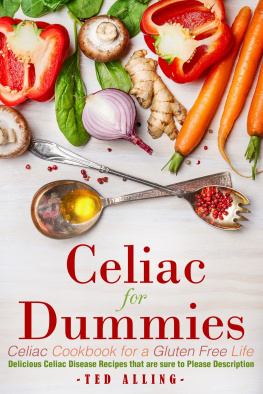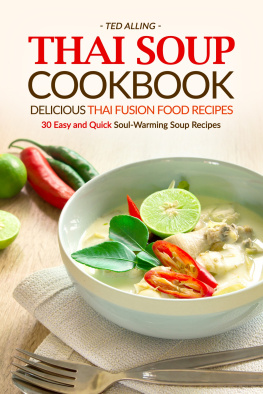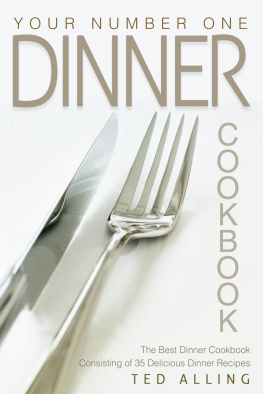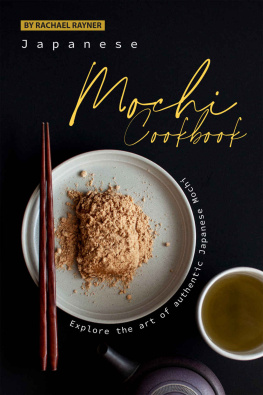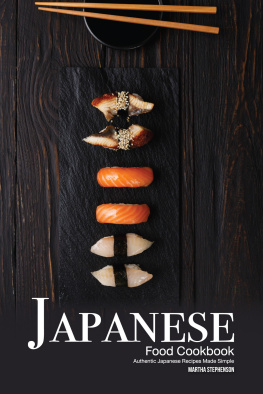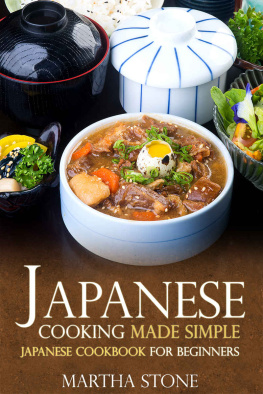Ted Alling - Japanese Cookbook, 25 Delicious Japanese Recipes from Authentic Japanese Cuisine: Enjoy Authentic Japanese Meals
Here you can read online Ted Alling - Japanese Cookbook, 25 Delicious Japanese Recipes from Authentic Japanese Cuisine: Enjoy Authentic Japanese Meals full text of the book (entire story) in english for free. Download pdf and epub, get meaning, cover and reviews about this ebook. year: 2016, publisher: Unknown, genre: Home and family. Description of the work, (preface) as well as reviews are available. Best literature library LitArk.com created for fans of good reading and offers a wide selection of genres:
Romance novel
Science fiction
Adventure
Detective
Science
History
Home and family
Prose
Art
Politics
Computer
Non-fiction
Religion
Business
Children
Humor
Choose a favorite category and find really read worthwhile books. Enjoy immersion in the world of imagination, feel the emotions of the characters or learn something new for yourself, make an fascinating discovery.

- Book:Japanese Cookbook, 25 Delicious Japanese Recipes from Authentic Japanese Cuisine: Enjoy Authentic Japanese Meals
- Author:
- Publisher:Unknown
- Genre:
- Year:2016
- Rating:3 / 5
- Favourites:Add to favourites
- Your mark:
- 60
- 1
- 2
- 3
- 4
- 5
Japanese Cookbook, 25 Delicious Japanese Recipes from Authentic Japanese Cuisine: Enjoy Authentic Japanese Meals: summary, description and annotation
We offer to read an annotation, description, summary or preface (depends on what the author of the book "Japanese Cookbook, 25 Delicious Japanese Recipes from Authentic Japanese Cuisine: Enjoy Authentic Japanese Meals" wrote himself). If you haven't found the necessary information about the book — write in the comments, we will try to find it.
Ted Alling: author's other books
Who wrote Japanese Cookbook, 25 Delicious Japanese Recipes from Authentic Japanese Cuisine: Enjoy Authentic Japanese Meals? Find out the surname, the name of the author of the book and a list of all author's works by series.
Japanese Cookbook, 25 Delicious Japanese Recipes from Authentic Japanese Cuisine: Enjoy Authentic Japanese Meals — read online for free the complete book (whole text) full work
Below is the text of the book, divided by pages. System saving the place of the last page read, allows you to conveniently read the book "Japanese Cookbook, 25 Delicious Japanese Recipes from Authentic Japanese Cuisine: Enjoy Authentic Japanese Meals" online for free, without having to search again every time where you left off. Put a bookmark, and you can go to the page where you finished reading at any time.
Font size:
Interval:
Bookmark:
Japanese Cookbook 25 Delicious Japanese Recipes from authentic Japanese Cuisine Enjoy Authentic Japanese Meals By Ted Alling
Copyright 2016 Ted Alling Kindle Edition 
License Notes
All ideas, suggestions and guidelines mentioned here are written for informative purposes. While the author has taken every possible step to ensure accuracy, all readers are advised to follow information at their own risk. The author cannot be held responsible for personal and/or commercial damages in case of misinterpreting and misunderstanding any part of this Book
About the Author
 Hello my name is Ted Alling, For as long as I can remember, I have always loved cooking and spending time in the kitchen. I honestly thought that my mother had dedicated her life to cooking, but later on in life, I came to understand that she was just a great stay at home mom of 4. Although I was a boy, I was always the only one interested in helping my mom make pancakes, fried eggs, and bratwurst.
Hello my name is Ted Alling, For as long as I can remember, I have always loved cooking and spending time in the kitchen. I honestly thought that my mother had dedicated her life to cooking, but later on in life, I came to understand that she was just a great stay at home mom of 4. Although I was a boy, I was always the only one interested in helping my mom make pancakes, fried eggs, and bratwurst. She proceeded to teach me how to make pasta, to cook chicken, stuff cabbages, and even how to make a pretty good risotto. Life in Germany was wonderful as a kid, but my parents decided to move to the United States, or more specifically to the state of Illinois, in 1990. When I moved out to go to college in Georgia, not only was I able to make some delicious dishes, but I was a very popular roommate to haveI was one of the very rare ones who could prepare something other than mac & cheese from the box. The other students from the dorm really dug my special fried rice. Until this day, I wont give out the secret ingredient that makes it unique I graduated from college with honors and an accounting degree in 1995, and soon after started working in a firm in downtown Atlanta. All I could think about all day was what I would make for my girlfriend for dinner.
She obviously did not mind that I had taken over the kitchen early on in our relationship. She is a nurse, and often has to work long hours and comes home exhausted and hungry. However, food had become much more than a hobby or necessity for meit was actually closer to an obsession, but I prefer to use the term passion. I was spending most of my weekends visiting fresh local markets and discovering new produce and herbs. After working as an accountant for 5 years, I realized that life was far too short to continue missing out on my true calling: cooking. I applied as a part time cook at a local diner about 10 minutes from home, and the rest, as they say, is history.
Three years later I was opening my own restaurant with my wife as my main partner. All my ex-fellow accountants now come in to eat at lunch time. We have been serving our clientele my famous fried rice, and many more dishes that I will be glad to share with you over the future weeks. What makes me a good chef? My passion for food, and the fresher the ingredients, the better. I love to experiment with flavors and I dare you to do the same. Sure, we all have our favorites, but dont settle in your ways.
Be creative. Play with the colors, the herbs, the spices, the types of meat, fruits, and vegetables. Grow your own garden and talk to your butcher about trying different cuts of meat that he has to offer on a weekly basis. Now, I have to go back to the kitchen, but next time you feel like preparing a mouthwatering dish, please stop by, and I will make sure to share most of my secrets.
Table of Contents
Introduction
 Japanese cooking is not just a way to prepare food and food is not just a way to fill their stomach. Cooking and eating both are meant to enrich your soul and nourish your body.
Japanese cooking is not just a way to prepare food and food is not just a way to fill their stomach. Cooking and eating both are meant to enrich your soul and nourish your body. Before preparing Japanese Cuisine, you have to understand fundamental principles of Japanese cooking. The Japanese believe that the cooking should appeal your all five senses other than sight, smell and taste. You will need hearing sense (quiet atmosphere while eating) and touching (feel the texture of food) sense. Meals should encompass five important colors, such as white, black, yellow, green and red. Classical Japanese meals should incorporate all five flavors, such as sweet, salty, bitter, sour and umami. The meal should include delicious dishes prepared in different ways, such as simmered, steamed, broiled, grilled and deep-fried.
Japanese ingredients are available in the market, and you should arrange these ingredients to get an authentic taste in your food. Japanese cooking is an art and you have to learn to grasp Japanese recipes. Try to use fresh ingredients and stay away from canned and frozen ingredients. Basic Japanese recipes are easy to follow to prepare its traditional meals. There are several types of Japanese meals and some of these meals are quite similar to Western meals. In order to cook various Japanese meals, it is essential to have basic cooking skills.
These skills will help you to fill your table with a variety of colors. This Japanese Cookbook is designed for your assistance with 25 recipes that are easy to follow and you can improve your culinary skills.
Traditional Japanese Ingredients
In order to cook Japanese food, it is essential to buy all traditional ingredients that are required to cook Japanese recipes. There are ten essential ingredients required to prepare traditional Japanese meals:
Japanese Rice Japanese rice is essential to use in Japanese cooking and you should select these authentic rice. Some people use Thai rice or Jasmin rice, but these will not work. There are different brands of Japanese rice, but you are recommended to use Japanese rice made in the United States of America.
Koshi Hikari and Akita Komachi are also good in taste. These are made in California. 
Japanese Soy Sauce Soy sauce is produced in several countries, but Usukuchi in light color and Koikuchi in black color are good for everyone. You have to buy Japanese soy sauce and Kikkoman is a famous brand easily found in the international market. 
Sake Sake is frequently used in Japanese cooking and it is similar to white wine that is used in western cooking. White wine can be a substitute of sake, but make sure to avoid white wine with a sweet taste.
Sumobox is a great choice for Japanese cooking. 
Mirin Mirin is a condiment frequently used in Japanese cuisine. It consists of almost 50 percent sugar and it is a special kind of rice wine that is parallel to Sake. It can give a sweet taste to your dishes and reduce the smell of particular seafood. It is good to give a shiny appearance to your vegetables. 
Font size:
Interval:
Bookmark:
Similar books «Japanese Cookbook, 25 Delicious Japanese Recipes from Authentic Japanese Cuisine: Enjoy Authentic Japanese Meals»
Look at similar books to Japanese Cookbook, 25 Delicious Japanese Recipes from Authentic Japanese Cuisine: Enjoy Authentic Japanese Meals. We have selected literature similar in name and meaning in the hope of providing readers with more options to find new, interesting, not yet read works.
Discussion, reviews of the book Japanese Cookbook, 25 Delicious Japanese Recipes from Authentic Japanese Cuisine: Enjoy Authentic Japanese Meals and just readers' own opinions. Leave your comments, write what you think about the work, its meaning or the main characters. Specify what exactly you liked and what you didn't like, and why you think so.


